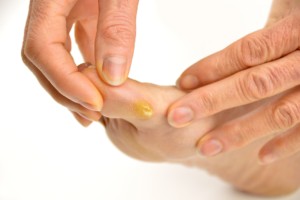Discovering that the soles of your feet have turned yellow can be unsettling. While in some instances, it might signal an underlying health issue that requires attention, in many cases, the causes are benign and easily addressed. The team at why.edu.vn is here to explore the primary reasons why you might notice your feet yellowing and what steps you can take.
Common Causes of Yellow Feet Bottoms
Several factors can contribute to the yellowing of the skin on the bottom of your feet. Here are some of the most frequent culprits:
1. Calluses: A Natural Skin Response
Calluses are thickened layers of skin that develop as a protective mechanism against friction and pressure. They are essentially your body’s way of shielding itself from potential damage. These can appear on various parts of the feet, including the bottom, and range from small, localized patches to larger areas covering the entire sole.
While some calluses present as dry and rough, potentially leading to cracked heels, others can feel rubbery and exhibit a yellowish hue. This yellow appearance is due to the thick callus obstructing the normal skin color, which is typically pinkish due to the oxygenated blood flowing through arteries and capillaries. The dense layer of dead skin cells in a callus effectively masks this natural coloration, resulting in a yellowed patch.
2. Diet and Carotenemia: The Impact of Food Choices
Your diet can significantly influence your skin color. Two conditions linked to dietary factors that can cause yellowing are anemia and carotenemia.
Anemia, characterized by a deficiency in red blood cells, means your body isn’t carrying enough oxygen to its tissues. Insufficient hemoglobin, the protein in red blood cells responsible for oxygen transport, leads to a reduced supply of oxygen to the skin. Additionally, the body prioritizes blood flow to vital organs, diverting it away from the skin surface. This combination can result in a pale, sometimes yellowish, skin tone.
Carotenemia arises from elevated levels of carotenoids in the body. Carotenoids are pigments found in many fruits and vegetables, particularly orange-colored ones like carrots. Excessive consumption of these foods over time can lead to a noticeable yellowing of the skin, especially on the palms of the hands and the soles of the feet. Furthermore, certain health conditions such as diabetes, liver, kidney, thyroid, and cholesterol imbalances can impair the body’s ability to process and eliminate carotenoids, also contributing to carotenemia.
3. Raynaud’s Phenomenon: Blood Flow Restriction
Raynaud’s phenomenon is a condition that affects blood vessels, causing them to narrow and restrict blood flow, particularly in the extremities like fingers and toes. When blood flow to the feet is restricted, they can quickly turn pale or yellow. Triggers for Raynaud’s episodes include exposure to cold temperatures and emotional stress.
The yellowing associated with Raynaud’s tends to be more uneven and patchy compared to other causes. It can affect different areas of the feet, both on the tops and bottoms, depending on the blood vessel constriction.
4. Jaundice: A Sign of Bilirubin Buildup
Jaundice is a condition characterized by the yellowing of the skin and whites of the eyes. It occurs when there’s an excess of bilirubin, a yellow pigment, in the blood. Bilirubin is a natural waste product produced when red blood cells break down.
When bilirubin accumulates to high levels, it can manifest as yellowing of the skin, including the feet. Jaundice is often associated with underlying medical conditions that affect the liver, gallbladder, or red blood cells. These conditions can range from infections and liver disease to bile duct blockages and certain blood disorders. If you suspect jaundice, especially if you notice yellowing in the whites of your eyes, it’s crucial to consult a doctor promptly to determine the underlying cause and receive appropriate treatment.
Yellow Toenails vs. Yellow Feet Bottoms: Is It Fungus?
It’s important to distinguish between yellowing of the skin on the bottom of your feet and yellow toenails. If the yellow discoloration is primarily affecting your toenails, the most likely culprit is a fungal toenail infection.
Fungal infections of the toenails are common and can cause the nails to turn yellow or white, become thick, brittle, and crumbly. Over time, untreated fungal infections can worsen, potentially leading to nail lifting and separation from the nail bed. If you notice these changes in your toenails, seeking treatment for a fungal infection is recommended.
When to Seek Professional Advice
While some causes of yellow feet bottoms are harmless and easily managed, others may indicate an underlying health concern that requires medical attention. If you are worried about the yellowing of your feet, or if it is accompanied by other symptoms such as pain, swelling, or changes in your overall health, it is always best to consult with a healthcare professional.
For concerns specifically related to your feet, podiatrists are specialists in foot and ankle care. They can accurately diagnose the cause of your yellow feet and recommend the most appropriate course of action. Don’t hesitate to seek professional help to ensure the health and well-being of your feet.

